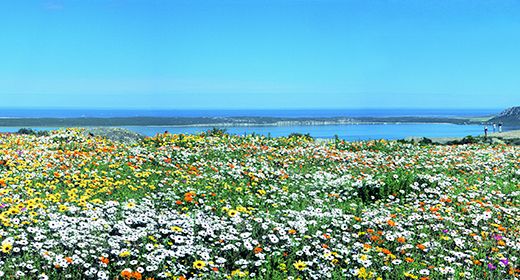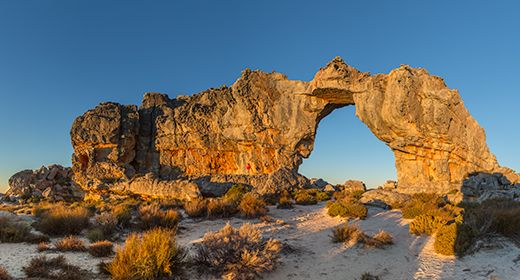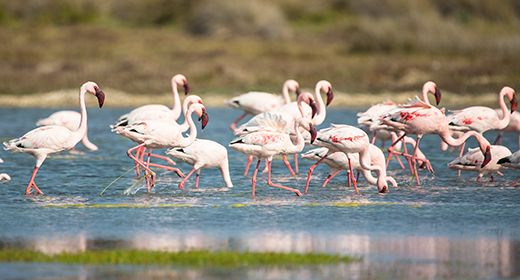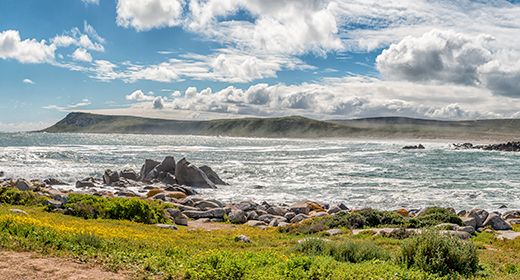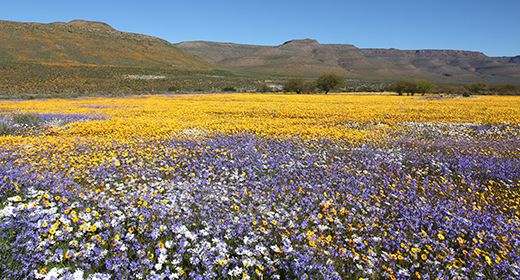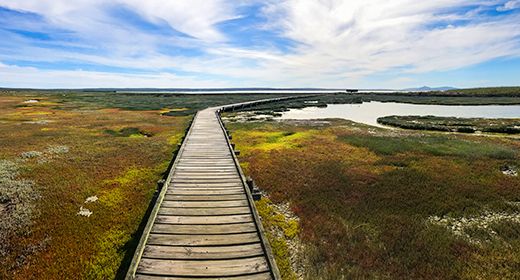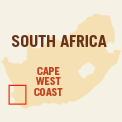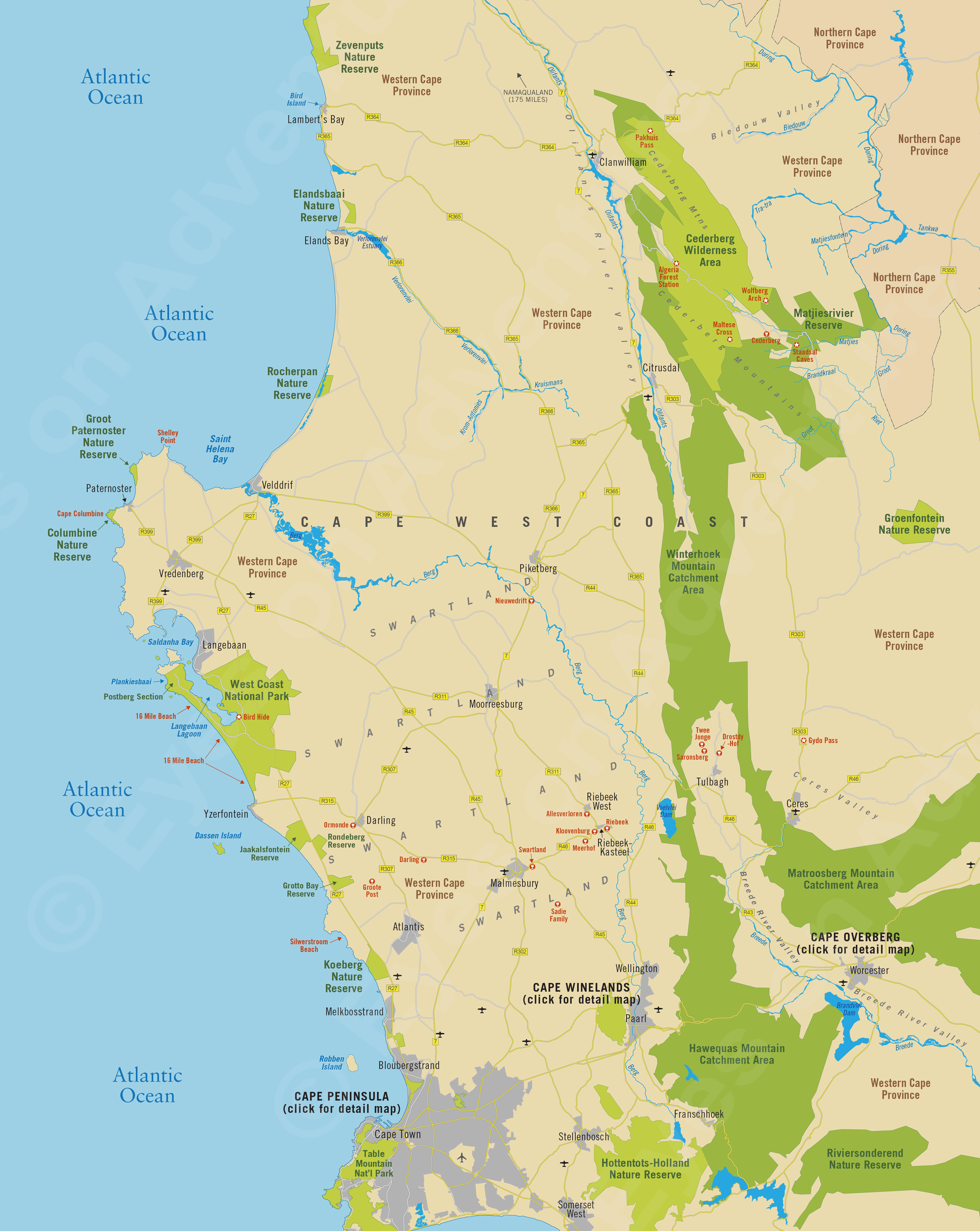Cape West Coast
(incl. Cederberg, Clanwilliam, Darling, Langebaan, Riebeek, West Coast NP)
Region Links: Cape Peninsula, Cape Town, Cape West Coast, Cape Winelands, Eastern Cape, Garden Route, Gauteng Province, Johannesburg, Kruger Park & Lowveld, Kruger Private Reserves, KwaZulu-Natal, Madikwe, Overberg & Whale Coast, Pilanesberg & Sun City, Sabi Sand Reserve
Highlights
- Experience the spectacular springtime wildflowers the bloom in the region between Aug and Oct
- Hike in the Cederberg Wilderness Area for beautiful scenery and San rock art sites
- Visit West Coast National Park for Langebaan Lagoon and excellent bird life
- Explore the fertile Swartland and sample wines from Riebeek West and Riebeek-Casteel
EOA Recommends: Bartholomeus Klip Farmhouse, Bushmans Kloof Koro Lodge (Sole Use), Bushmans Kloof Lodge
South Africa's West Coast is a remote and starkly beautiful region, with coastal wilderness, the Cederberg mountains, the fertile Swartland, and seemingly endless miles of deserted Atlantic Ocean coastline.
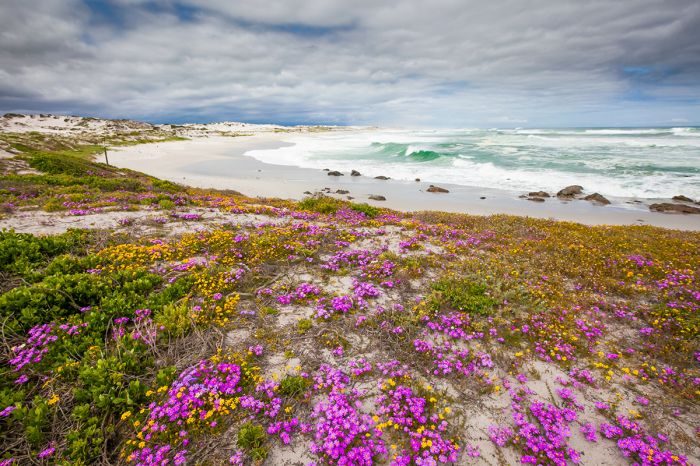
Wildflowers in bloom along a beach in the Cape West Coast
The Cape West Coast is a place of few people, miles of wilderness, unending skies, farmland, inland mountains, and spectacular scenery.
The Cederberg range of mountains inland and to the north is an unspoiled wilderness and a hiker's paradise. In springtime (August and September), the entire area comes alive with a carpet of wildflowers. The mountains are also known for the ancient San rock art paintings.
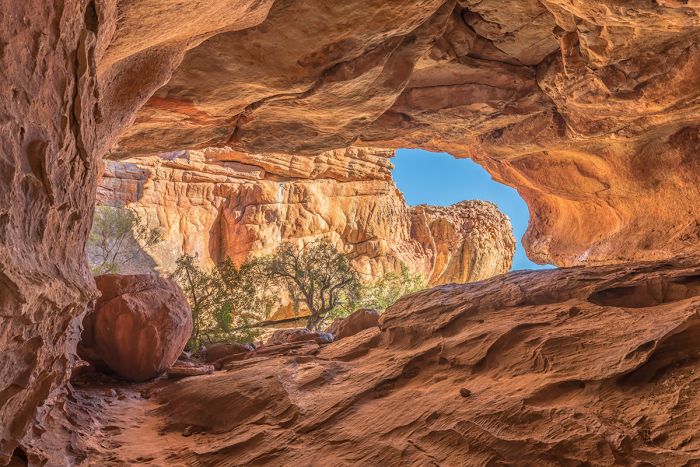
Stadsaal Cave, a San rock art site in the Cederberg Mountains
Coastal Langebaan, Paternoster, and the West Coast National Park are the region's most visited destinations and a great place from which to base an exploration of the Cape West Coast. The Langebaan Lagoon is great for water sports like kite surfing and windsurfing and the national park supports some wildlife and excellent bird life.
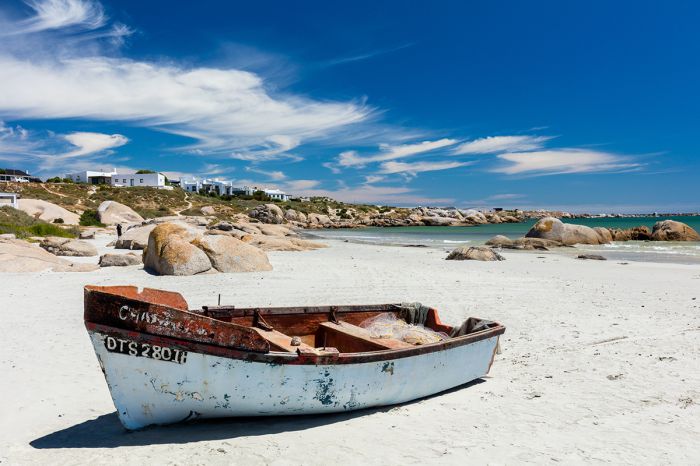
Small fishing boat on the beach at Paternoster, South Africa
The picturesque Swartland region, meaning 'black land" and referring to either the rich soils or the predominantly dark-colored renosterbos vegetation occuring here, begins just north of Cape Town and extends north to Piketberg and east to Riebeek. The region supports a robust wine and wheat industry. Rolling fields of wheat, interspersed with vineyards cover the land all the way to the mountains in the east.
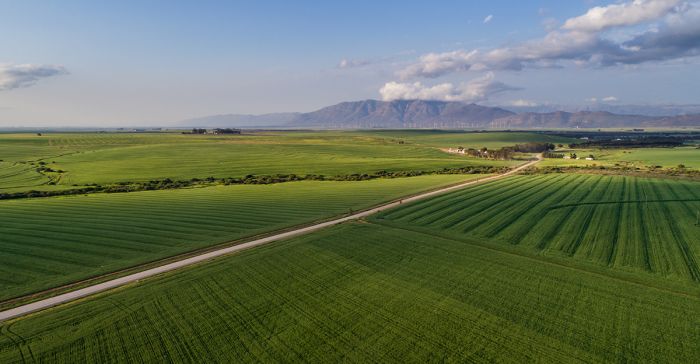
Wheat fields in the Swartland region, Cape West Coast, South Africa
The West Coast region is one of South Africa's least visited destinations, but one of its best-kept secrets. Those with a taste for adventure, natural beauty and no crowds will find it well worth the time to explore. A minimum of three days is required, but a week is recommended.
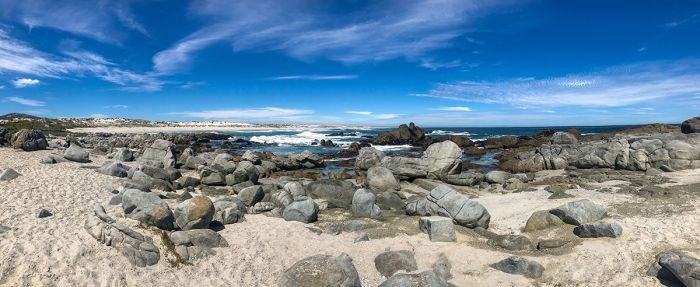
Coastline and ocean at the West Coast National Park
Read More...
Cape West Coast, Cederberg, Ceres, Clanwilliam, Columbine Nature Reserve, Elands Bay, Lambert's Bay, Langebaan, Paternoster, Riebeek, Swartland, Tulbagh, West Coast National Park, Velddrif, Wildflowers
Cape West Coast
The Cape West Coast of South Africa stretches from Cape Town in the south to Lambert's Bay in the north and inland to the Cederberg and Winterhoek mountain ranges. This is a sparsely populated and little visited area, but it offers some beautiful and diverse destinations that are well worth the time to visit.
The region is best known for the miles of Atlantic Ocean coastline, the spectacular wildflowers that bloom in profusion in the spring, the inland mountains that are great for hiking, and the rich farmlands in the Swartland.
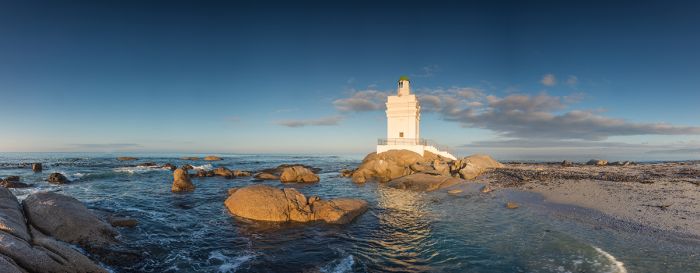
Stompneusbaai lighthouse at Shelley Point in Saint Helena Bay
Wildflowers
One of the top attractions of the Cape West Coast (and also in Namaqualand, located in the Northern Cape) are the beautiful wildflowers that carpet the landscape in colors during the spring months of August thru October. Floral displays of orange, white, yellow, and purple cover fields as far south as Darling, westward all the way to the Atlantic Ocean beaches and inland to and beyond the mountains in the east.
West Coast National Park is always good for wildflowers, as are the areas around Cape Columbine and Lambert's Bay. Clanwilliam and the Biedow Valley are also reliable places and there are routes mapped out especially for wildflower viewing.
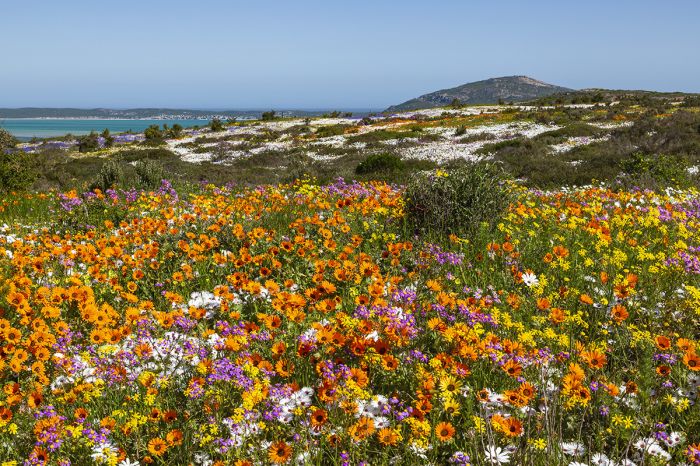
West coast wildflowers in bloom
Approximately 4 000 species of flowers grow in the region, most of them belonging to the Daisy and Mesembryanthemum groups and about one-quarter of which are found nowhere else. Flower blooms vary year-to-year and are highly dependent on rains in the winter. Blooms generally begin along the coast and move inland as the weeks pass.
Viewing the flowers means lots of driving and some planning is recommended. The tourism offices in Darling, Saldanha, and Clanwilliam can provide current info and advice, as can your accommodation hosts. Remember to take lots of photos, but never pick the flowers.
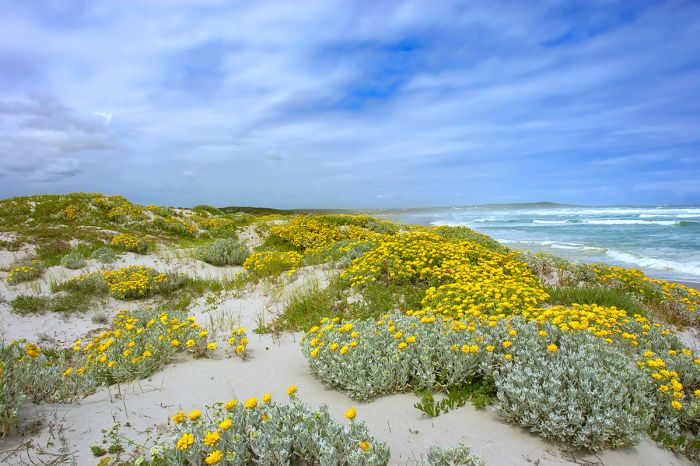
Wildflowers blooming between Grotto Bay Reserve and Silwerstroom Beach
Swartland
The N7 highway north out of Cape Town leads directly into the fertile country known as Swartland, which means "Black Country", referring to the soils and/or the dark renosterbos (rhinoceros bush) vegetation that is native to the area.
Swartland is a place of rolling wheat fields that extend for miles in all directions. There is also a flourishing wine industry here, with numerous wine farms producing some wonderful and earthy reds. The area also supports some dairy farms, horse breeders, and tobacco crops.
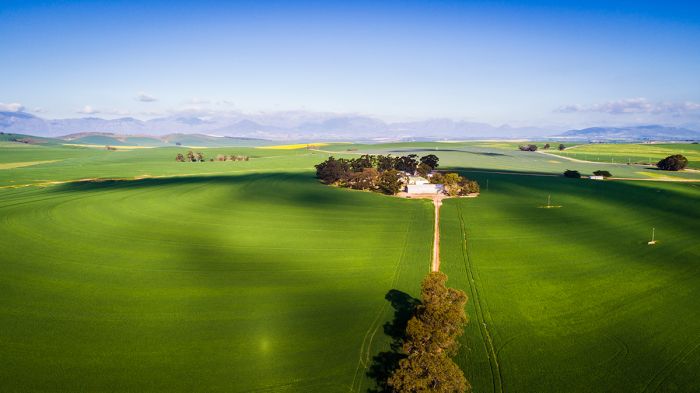
Wheat fields in the Swartland region, Western Cape, South Africa
The little country town of Darling is best known for its wildflowers in the springtime (August thru October), vineyards, and dairy farms.
The well-known South African performer, author, satirist, and social activist Pieter-Dirk Uys, lives in Darling. He has converted the old, disused railway station in town, into a cabaret theatre and restaurant called Evita se Perron, where he regularly performs. The very popular rock music festival, Rocking the Daisies, is held in Darling every October. The northern side of town has some lovely old Victorian architecture.
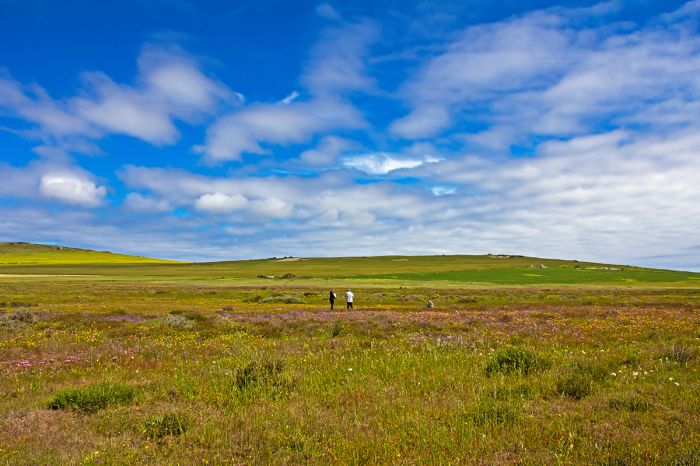
Walking thru wildflowers in the Tienie Versveld Nature Reserve, near Darling
Riebeek-Kasteel & Riebeek West
The twin Swartland towns of Riebeek-Kasteel and Riebeek West are both named for Jan van Riebeek, who established the first Dutch settlement in the Cape in 1652. The two towns, situated a stone's throw from one another, originated in tandem over a dispute regarding where to place a church and in the end, two churches were built and a separate town grew around each. Kasteel (meaning Castle) refers to the Kasteelberg mountain which towers over the towns.
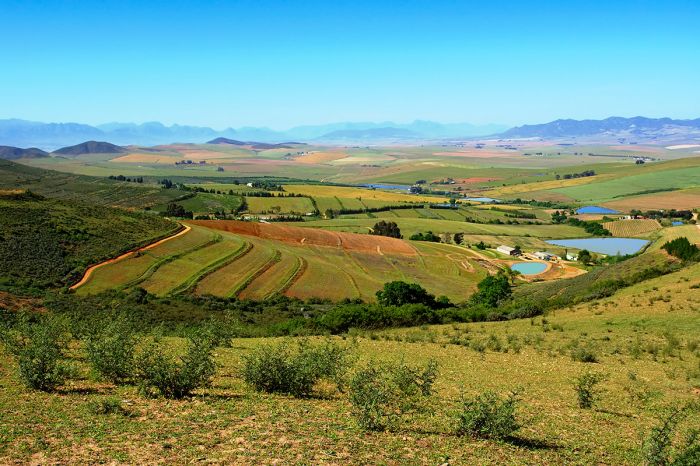
Vineyards and farming around Riebeek West and Riebeek-Kasteel
Riebeek-West is the birthplace of two of South Africa's most famous historic politicians, Jan Smuts and D.F. Malan. Smuts was prime minster of the Union of South Africa from 1919-1924 and 1939-1948 and was also a military leader in the Second Boer War. Malan was prime minister from 1948-1954 and it was at this time that the country laid the foundations of apartheid. Malan was born on the Allesverloren farm, which produces stellar wines.
The leisurely pace of life here has made the twin towns very popular with Capetonians, who more and more are using it as a weekend getaway or even moving here and commuting into the city for work. There are plenty of restaurants, some very good wine estates, acres of olive groves, and art galleries, making this a destination worthy of a day or two.
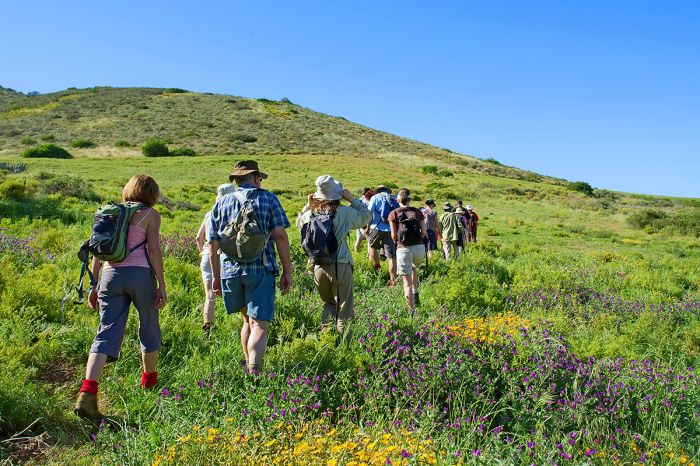
Hikers in the Kasteelberg Nature Reserve just outside of Riebeek-Kasteel
Langebaan
The coastal town of Langebaan is the region's most visited destination and touts itself as the gateway to the West Coast National Park. The town is very laid-back and the calm waters and white sand beaches of its salt water lagoon are popular for water sports, including sailing, kitesurfing, windsurfing, kayaking, and fishing. The lagoon was formed by successive changes in sea levels during prehistoric times.
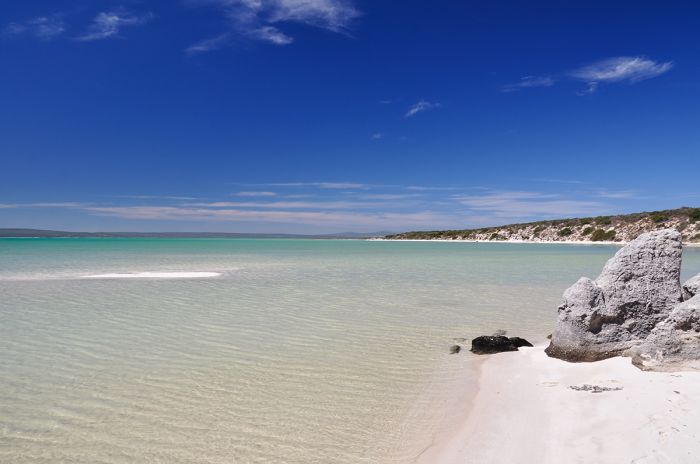
Langebaan Lagoon in the West Coast National Park
The town was founded in 1922 to support the whaling industry and was the largest whaling station in the Southern Hemisphere until the 1960s.
Today the town is a popular destination for those visiting the national park and for tourists coming for the wildflowers in springtime (August-October). The town is relatively quiet in the off-season fall and winter months, but gets quite busy in the spring and summer. There is a law prohibiting any major industry but it is nonetheless becoming overdeveloped with vacation homes due to its popularity amongst Capetonians, who flock here on the weekends.
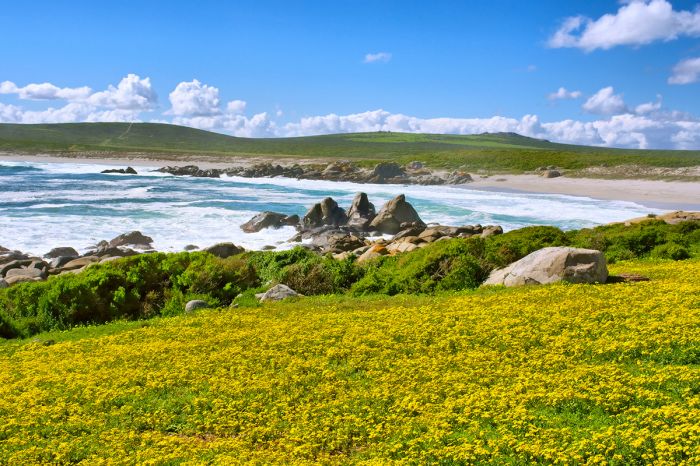
Wildflowers along the coast at Langebaan
West Coast National Park
The jewel of the region, West Coast National Park is a wilderness that encompasses most the Langebaan Lagoon and huge tracts of pristine strandveld (fynbos-covered dunes and grassland) and salt marshes. Drive into the park and stop along the way to enjoy the well-marked and educational walking trails through the dunes, where one can see and learn about the coastal fynbos vegetation growing here. The views over the shimmering blue lagoon are wonderful.
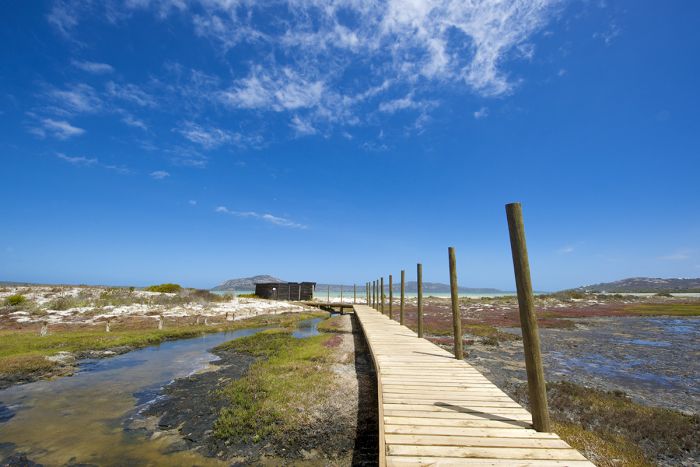
Walkway in the West Coast National Park, South Africa
The park is a bird watcher's paradise, especially in the spring, when thousands of Palearctic migrants arrive to feed in the salt marshes and mud flats along the southern curve of the lagoon. Curlews, flamingos, greenshanks, stilts, avocets, turnstones, sandpipers, and more are here in profusion at this time.
The northern tip of land west of the lagoon is the Postberg Section and is only open to visitors during the spring wildflower season (Aug-Oct). Here you can see zebra, oryx (gemsbok), wildebeest, and bat-eared fox. The park also hosts plentiful tortoises. The park is reachable as a day-trip from Cape Town or book accommodation in Langebaan well in advance.
The park can easily be visited as a day trip from Cape Town, with a drive time of around 90 minutes, but during flower season, one would be advised to stay longer than a day!
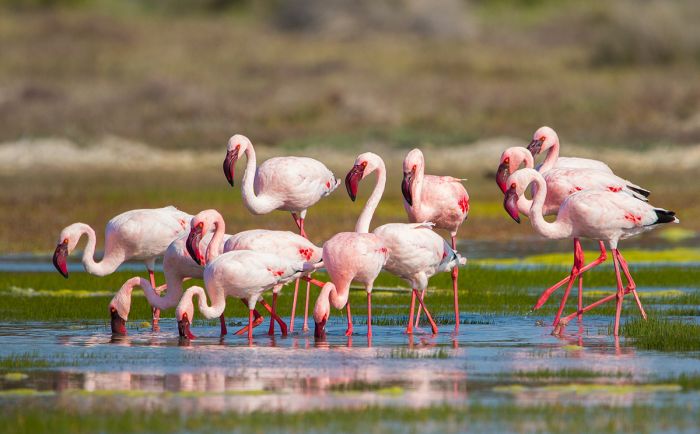
Lesser flamingos in West Coast National Park
Paternoster
The mostly unspoiled little coastal town of Paternoster is a 30-minute drive north from Langebaan. It's another popular seaside getaway for Capetonians and its small population consists mainly of fisherfolk, who have subsisted here for generations by small-scale fishing and crayfish netting. Like many such little towns, some of its character is being lost to upscale homes popping up alongside the original whitewashed cottages of the coloured fishing families.

The beach at Paternoster
Just south of Paternoster is the small and coastal Columbine Nature Reserve, set aside to preserve the sandveld and fynbos vegetation. The park offers some excellent coastal hiking trails thru the huge dunes and leading to the sea, which is defined by huge boulders, little coves, and beaches with turquoise water. The reserve is a great spot for the spring wildflowers and also for birding, where one can see sacred ibis, cormorants, and the endangered African black oystercatcher.

Beach in the Columbine Nature Reserve
Velddrif
The final town along the R27 out of Cape Town is Velddrif, another small fishing town located at the mouth of the Berg river. The annual Berg River Canoe Marathon starts in Paarl and ends at the Velddrif marina. Urban growth has spoiled some of the town's historic character, but its picturesque setting on the banks of the river and the wetlands surrounding the town make it worth a visit.
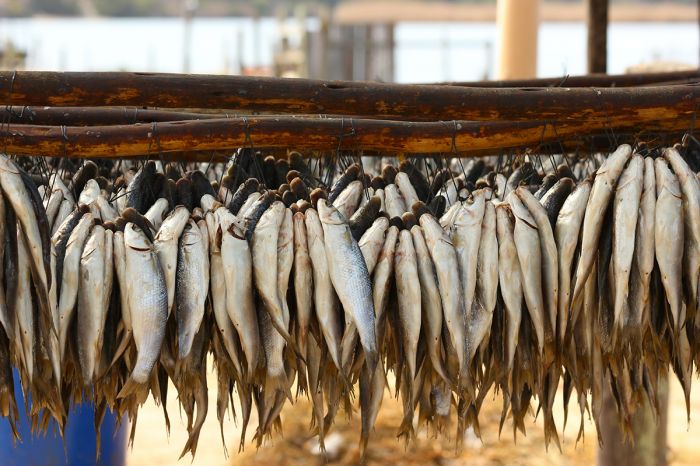
Bokkoms drying in Velddrif
Bird life along the river is superb, including flamingos and pelicans and small fishing boats still work the quiet backwaters near the Veldriff bridge. Dried and salted whole mullet fish, a west coast delicacy called bokkoms, can be seen drying in the wind on wooden scaffolds near the river banks.
Elands Bay
About two hours' drive north of Paternoster is the small town of Elands Bay. Like the other coastal towns to the south, it's a popular weekend destination for Capetonians and it remains mostly undeveloped, with only a few guesthouses and some restaurants.
Some of the Western Cape's best surfing is found here and the town itself has a pretty setting, straddling both shores of the Verlorenvlei river. The river and estuary are a birder's paradise, with over 240 species recorded. Nearby caves contain well-preserved rock art paintings dating back around 10 000 years. The springtime wildflowers are spectacular in the vicinity of town.
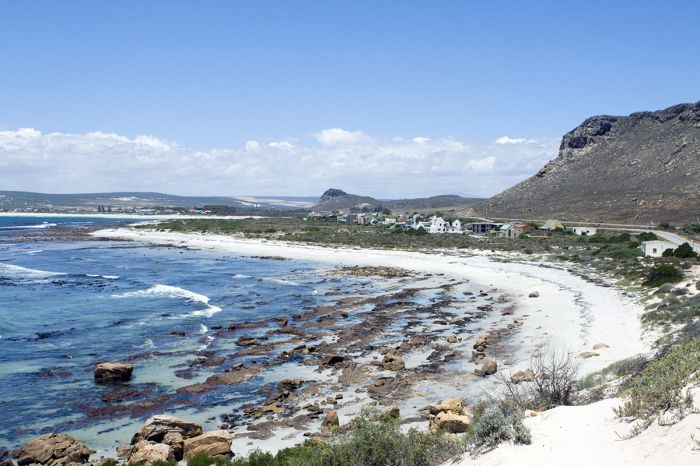
Elandsbaai or Eland's Bay on the west coast of South Africa
Lambert's Bay
The quiet little coastal town of Lambert's Bay is the last settlement of note along the Cape West Coast. To the north, it is mostly uninhabited all the way to Namibia.
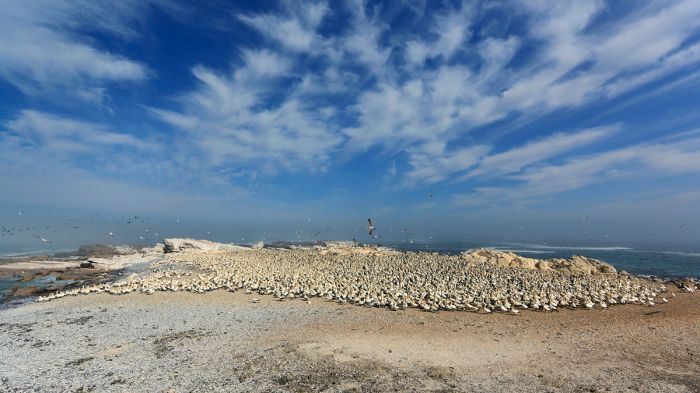
Cape gannet colony at Lambert's Bay
The chief attraction here is Bird Island, a small piece of land just offshore that is home to a breeding colony of around 10 000 Cape gannets and smaller numbers of African penguins and cormorants. Humpback whales breed in the waters offshore from July thru October and the attractively marked Heaviside's dolphins are often seen from shore or on boat trips from the harbor.
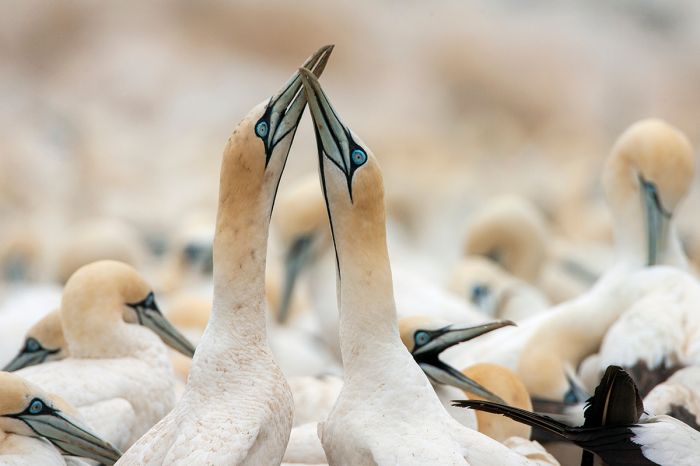
Cape gannets at Lambert's Bay
The Cederberg
Located just east of the Olifants river are the lofty sandstone mountains of the Cederberg (named for the cedar trees which once covered the mountains). These rugged and dramatic mountains are encompassed in the 270-sq-mile (700-sq-km) Cederberg Wilderness Area, which protects the catchment area and extends along the east side of the N7 between the small towns of Clamwilliam in the north to Citrusdal in the south.
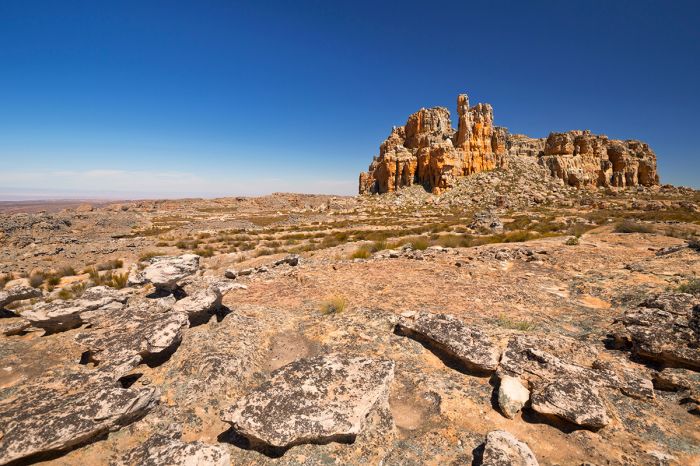
Dramatic landscape in the Cederberg Mountains, South Africa
The Cederberg is a recreational paradise, with over 150 miles (250 kms) of hiking trails that wind through spectacular red-hued rock formations, ancient San rock art sites, clear mountain streams, and montane fynbos vegetation. Popular rock formations in the southern portion of the Wilderness Area include Wolfberg Arch and the Maltese Cross.
The Cederberg contains around 2 500 known rock art sites that date back to 8 000 years ago and which were created by early hunter-gatherers known as the San Bushmen. The Staadsal Caves are particularly interesting and contain superb examples of prehistoric rock art.
The main road through the Cederberg starts at Clanwilliam and connects all the way to Ceres. Along this route is the Algeria Forest Station, the Cederberg office of Cape Nature Conservation, which manages the Wilderness area. This is the starting point for various hiking trails and offers camping sites.
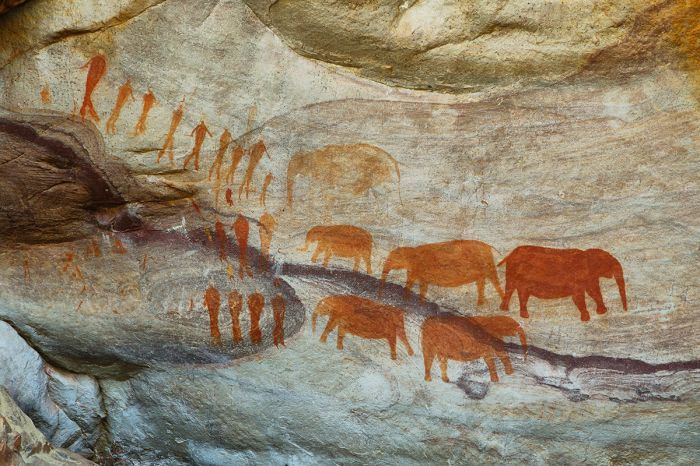
San rock art at the Staadsal Caves, Cederberg Mountains
Hiking in the Cederberg requires a permit, which can be obtained at the Algeria Station or the tourism offices of Clanwilliam or Citrusdal. There are many short hikes that can be accomplished in several hours or less, but multi-day hikes are more rewarding. Many of the local sheep farms have self-catering cottages on their land.
Visiting the Cederberg in the spring (Aug-Oct) is particularly recommended, as the landscape comes alive with carpets of wildflowers at this time.
Cederberg Private Cellar is the highest vineyard in the Western Cape at around 3 300 feet (1 000 kms). The farm produces numerous award-winning wines ands self-catering accommodations. The Cederberg Observatory is located on the farm and offers use of its telescopes.
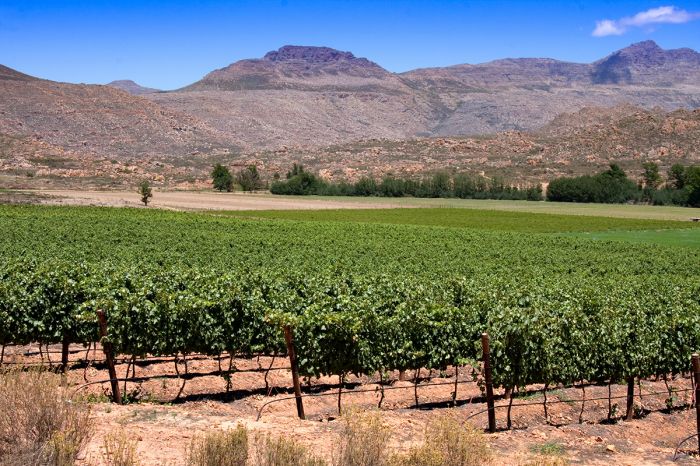
Vineyard in the Cederberg
Clanwilliam
On the northern edge of the Cederberg Wilderness Area is the small town of Clanwilliam. The town becomes overrun by flower-watching tourists in the springtime, but is otherwise rather quiet. The Ramskop Wildflower Garden showcases the region's floral beauty and is worth a visit, especially in August, when the flowers are at their best.
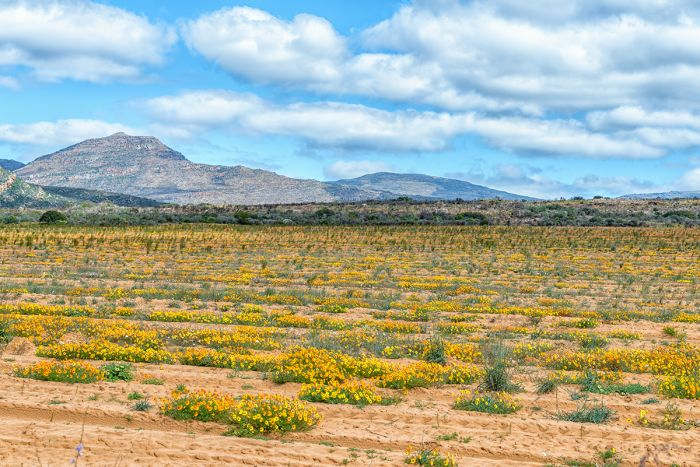
A Rooibos Tea field at Clanwilliam, South Africa
Clanwilliam is also the home of the Rooibos Tea industry. Rooibos (meaning "red bush"), is used to make a very South African, caffeine-free, herbal tea. Rooibos is one of the fynbos plants and only grows in the mountainous regions around Clanwilliam and Nieuwoudtville (a town further north in the Northern Cape). Tours of the tea processing facility in town are interesting.
Parkhuis Pass is a spectacularly scenic road over the mountains eastward out of Clanwilliam and there are some excellent rock art sites reachable from the town. The Biedouw Valley lies across the mountains from Clanwilliam and is one of the best spots for spring wildflowers. Driving to Clanwilliam from Cape Town takes about three hours without stopping, but stopping along the way is half the fun, so plan on a day.
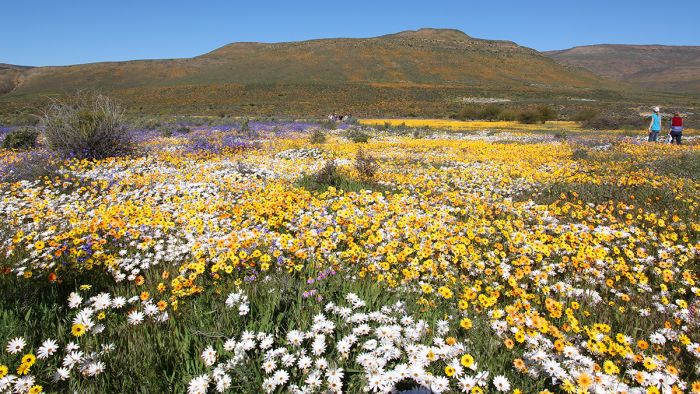
Wildflowers in bloom in the Biedouw Valley, Cederberg region near Clanwilliam
Ceres
The town of Ceres, named for the Goddess of Fertility, is known for its deciduous fruit farms and the South African juice brand of the same name. Apricots, pears, peaches, apples, nectarines, and cherries are grown in the Ceres Valley and tours of the orchards and fruit-packing houses are offered during the harvest season between December and April. The Dwars river, which flows through town, boasts excellent trout fishing.
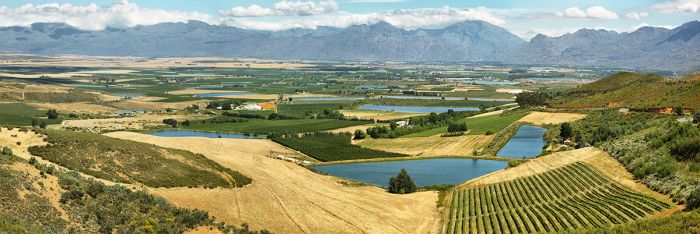
The fertile, fruit-producing Ceres Valley viewed from Gydo Pass
Nestled in a secluded valley bound on three sides by the Winterhoek and Witzenberg mountains is the little town of Tulbagh. Founded in 1743, the town was settled by early Dutch and French Huguenot families. The valley is known for its wine production, which in recent years has made huge strides in quality and there is now a Tulbagh Wine Route.
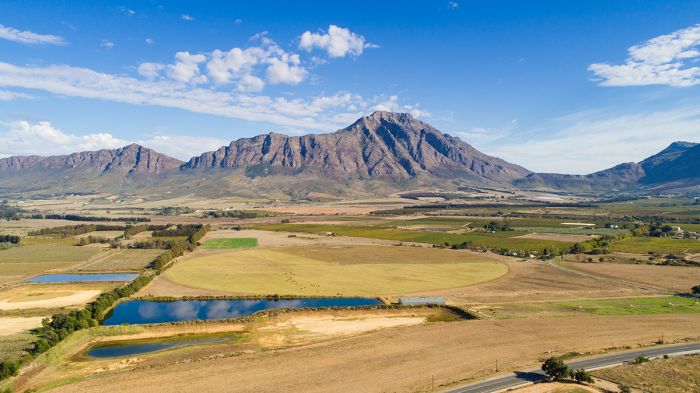
The Tulbagh Valley, with vineyards and farming
In September 1969 the area was hit by a devastating earthquake that caused substantial damage to the town. Many of the original facades on historic Church street were destroyed. Subsequent restoration projects have returned the town to its original character and today Tulbagh has perhaps the best collection of Cape-Dutch, Victorian, and Edwardian architecture on a single street in South Africa.
Read More...
Cape West Coast, Cederberg, Ceres, Clanwilliam, Columbine Nature Reserve, Elands Bay, Lambert's Bay, Langebaan, Paternoster, Riebeek, Swartland, Tulbagh, West Coast National Park, Velddrif, Wildflowers
Great Good Fair Poor
- Jan
- Feb
- Mar
- Apr
- May
- Jun
- Jul
- Aug
- Sep
- Oct
- Nov
- Dec
The Cape West Coast is defined by hot and windy summers and chilly, wet winters. Springtime weather is sunny and comfortable, but also brings more tourists, who come for the spectacular wildflowers.
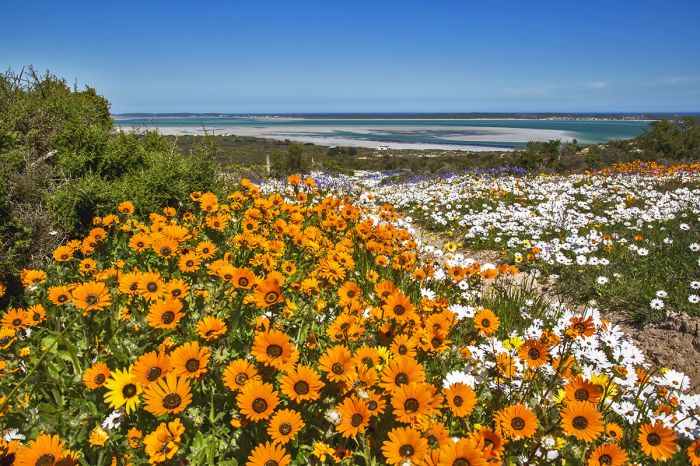
Wildflowers in bloom along the Cape West Coast, South Africa
August thru October (Spring)
Spring is arguably the best time to visit the Cape West Coast, as it is the season for the incredible wildflowers. Temperatures are lovely, averaging a low of 52°F (11°C) and a high of 77°F (25°C). August and September have 12-14 days where it rains some, but by October there are only 7 days of rain.
The West Coast region is never actually crowded, but spring brings the most visitors and if you're coming to look for wildflowers, it's best to book accommodations well in advance.
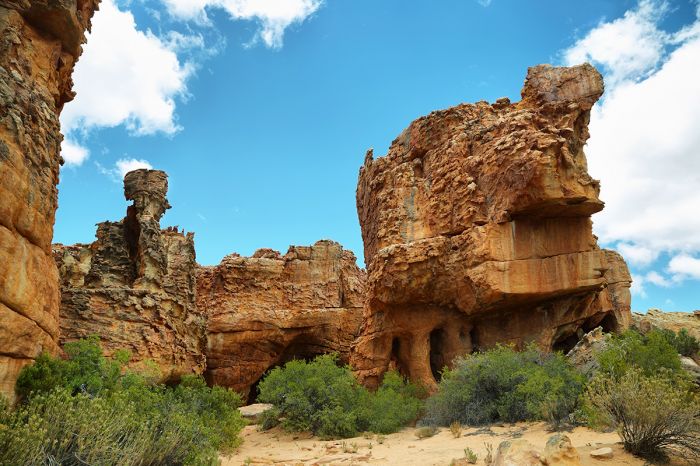
Stadsaal Caves in the Cederberg, a site for San rock art
NOVEMBER THRU FEBRUARY (SUMMER)
Differing from most places in South Africa, the Cape West Coast, experiences warm, dry weather during the summer (most of the country receives the majority of its rain in the summer). This is due to the Mediterranean climate the predominates in the region.
Summer can also bring windy days and the "Cape Doctor" (so named as it clears the air), a strong southeasterly wind can reach gale force speeds.
Summer temps average a low of 61°F (16°C) and a high of 82°F (28°C). Rain can occur but is very infrequent, with only 6 days per month receiving precipitation. February is the hottest month of the year, with temps sometimes topping 104°F (40°C).
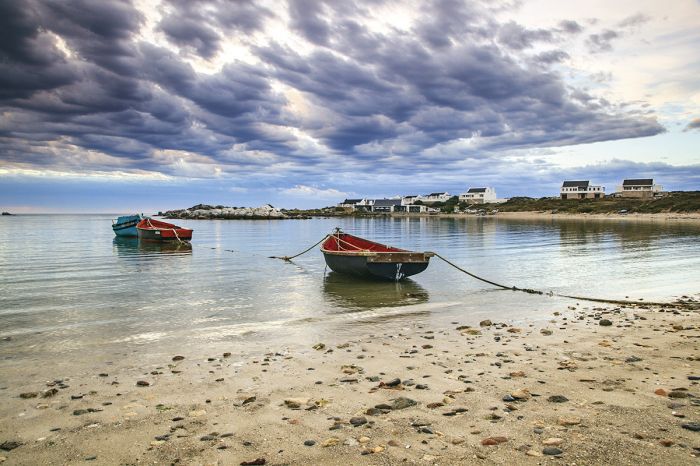
Fishing boats on the beach at Paternoster, South Africa
MARCH AND APRIL (FALL)
Marc and April are warm and generally dry. Temperatures range from average lows of 59°F (15°C) and highs of 81°F (27°C). The wind has mostly abated. Rain is still rare to nonexistent in March, but early rains can sometimes begin in April.
MAY THRU JULY (WINTER)
Due to the Meditteranean climate, winter means the rain and cool temperatures. Rain falls roughly 14 days per month and July is typically the coldest and wettest month. Average temps range from a low of around 48°F (9°C) to highs around 72°F (22°C).
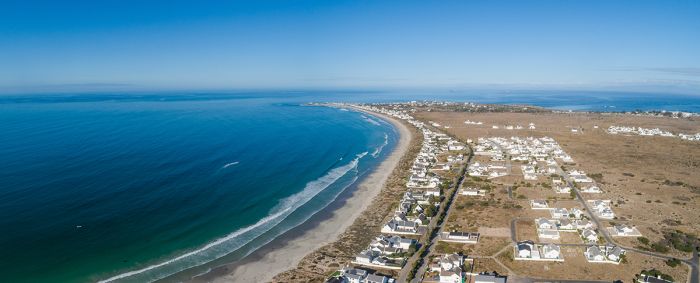
Shelley Point and Saint Helena Bay




